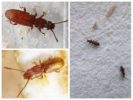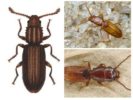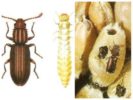- Ginger Mucoed
- Ginger Mucoed
- Ginger Mucoed
The kitchen unit is of most interest to domestic pests. In food stocks you can find a huge variety of wildlife, among which bread grinder, food moth and red-haired flour-eater. The latter is very demanding on living conditions, which greatly facilitates the fight against the pest.
Interesting!
In each apartment or house there are several types of insects. And if they are not visible to the naked eye, this does not mean that they are not. American scientists conducted an interesting study, during which they found that on average about 100 arthropod species live in one house. Of the 500 rooms, only five were not found a single insect.
What does a gingerbread cookie look like?
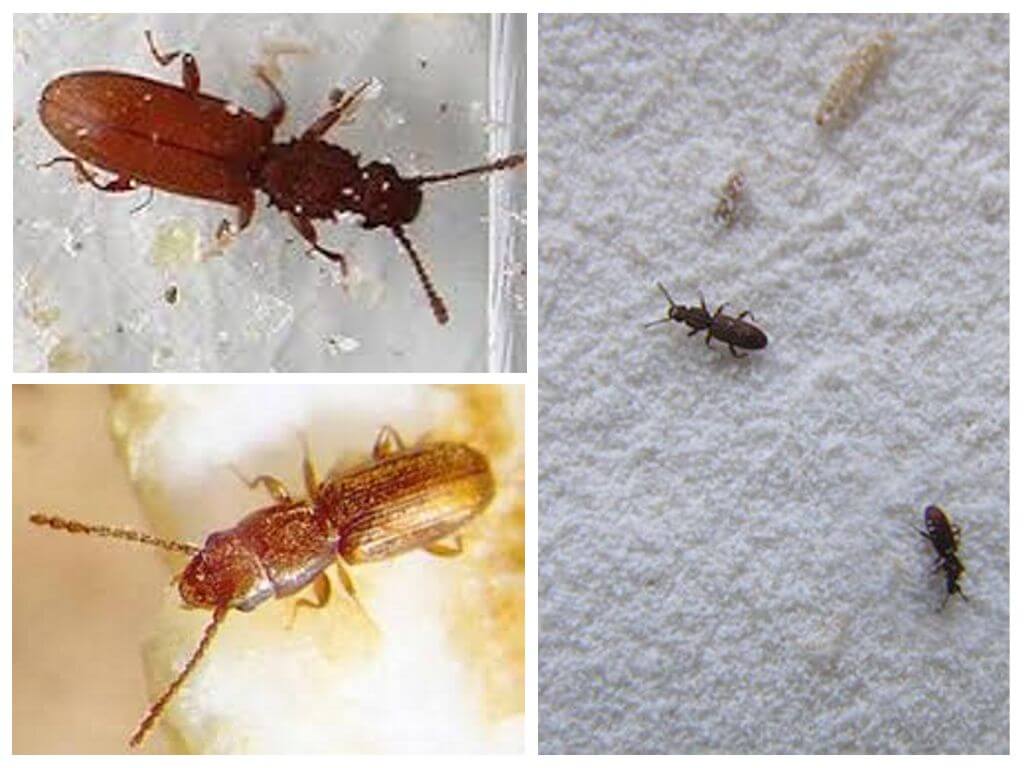
The red-headed fly-eater has several names. In foreign publications it is called the short-haired red-headed fly-eater. In Russian-language sources it is described as Surinamese flour-eater, and in everyday life they simply call saffron milk. The size of the beetle varies between 1.5-2.5 mm. And although the insect itself is distinguished by its miniature size, it prefers to live in huge storages, in mills, in industrial premises.
The name of the beetle accurately reflects its color - rusty yellow or copper color. The body is densely covered with hairs, the width of the head is almost the same size with the width of the body. If you carefully consider what the red-haired flour-eater looks like in the photo, you will notice a long mustache, which is slightly longer than the beetle itself. Well-developed wings help to make long flights, which is what the insect uses in search of a new food base.
Interesting!
The optimal conditions for the life and propagation of the mucoeater are increased air humidity of 65-70% and an ambient temperature of 20-25 ° C. Deviations from the norm slow down the development of the insect. Temperatures below 12 ° C and above 30 ° C greatly reduce the lifespan. Under optimal conditions, red-headed mukoed can go without food for up to 70 days, with low humidity, death occurs in 15-20 days.
The short-winged fly-eater differs from the red one by the length of the mustache, their length barely reaches half the body. The beetle is widespread everywhere, mainly in feed mills, flour mills. It multiplies very quickly and creates numerous colonies.
What does the pest eat
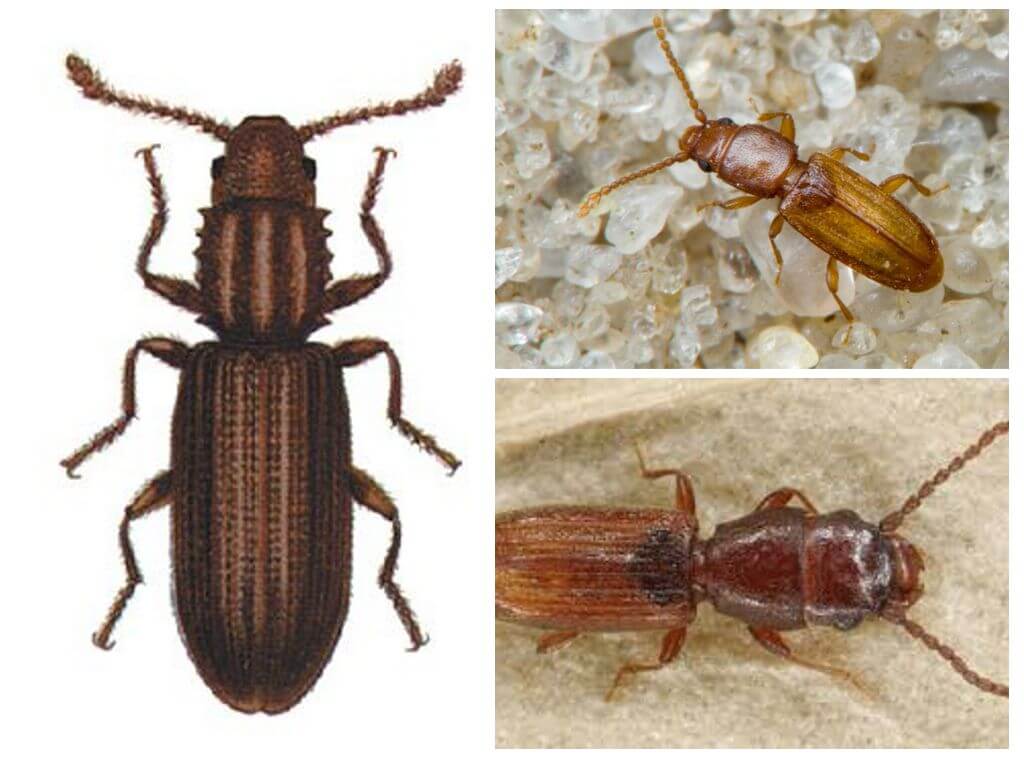
In industrial, storage facilities, barns, mills, granaries, the red-haired flour-eater is clogged in the cracks. It feeds on flour, rotten, crushed grains, cereals, pasta. Only foods whose moisture content exceeds 15% are suitable for insects. Adult individuals can feed on the larvae of other pests, including bark beetles, weevils.
Mukoedy get into the apartment with infected products. Small dimensions, flat body structure allow adult individuals and larvae to freely enter boxes, bags, bags and other containers for food. When it enters the nutrient substrate, the mucoeater begins an active life: eat and multiply. Such products do not bypass their attention:
- cereals, pasta, flour;
- flour and confectionery products;
- dried fruits, nuts, sunflower seeds, flax;
- dried vegetables.
Beetles are very shy and afraid of sunlight and bright light.For the most part, all of the above products are stored in a dark place, which creates favorable conditions for the development of flour eaters. Like many other pests, sensing a potential danger, the bug pretends to be dead. Due to its tiny size and immobility, it is mistaken for garbage and sent to the appropriate inventory using a broom. The beetle safely leaves the bin and continues to spoil the food.
Features of the reproduction of red flour-eaters
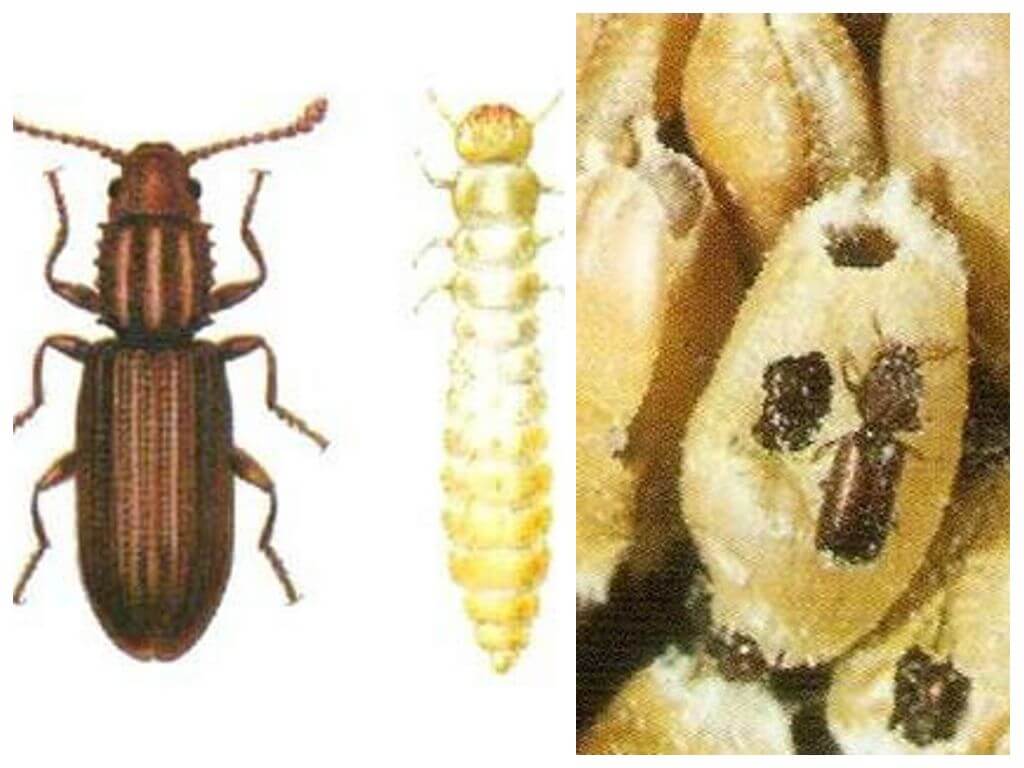
The female produces eggs on the products she eats. One individual lays several tens of eggs; there can be 3-5 generations per year. A few days later, white hairy larvae with a reddish tip of the abdomen appear from the eggs. As they grow, their length reaches 4 mm.
Pupation occurs in a nutrient substrate. The pupa is characterized by a creamy shade of the body, 2 spike-like outgrowths at the end and small dimensions of 2.5 mm. The full cycle of development from an egg to an adult is 65-100 days. Adults live 6 months.
How to get rid of red flour eaters
At home, the methods of struggle are reduced to creating unbearable conditions for mucoeders. To do this, they need to be deprived of the food base and not to allow increased humidity in the room. Spoiled foods should be discarded because only adults can be separated using a sieve, and the eggs will remain in the flour.
Important!
Food products, in which the gingerbread man has settled, become unsuitable for consumption and must be disposed of. Accumulating in numerous colonies, insects increase the humidity of products, clog them with waste products: excrement, skins.
The enterprises carry out a set of preventive and destructive measures:
- preliminary aerosol treatment of storage facilities;
- preparation of grain for storage, which consists in heating or cooling and in the processing of grains with insecticidal preparations;
- Regular monitoring of infected storage.
A conscientious attitude to the storage of grain products in warehouses and control over each batch of goods will avoid the spread of red flour-eaters.
